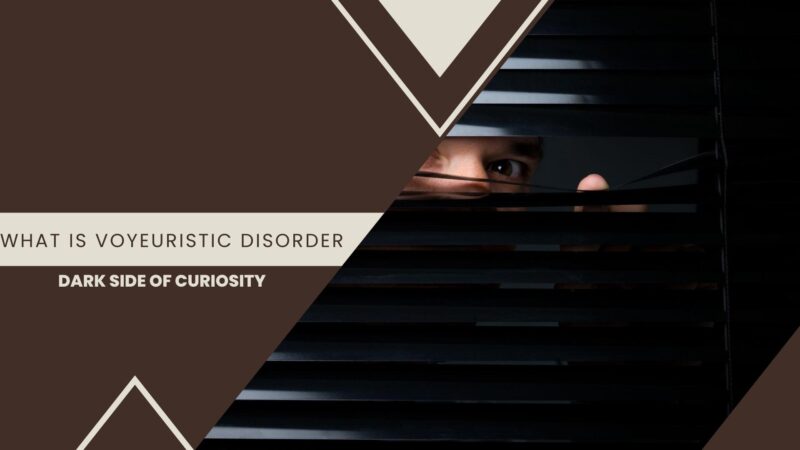Voyeuristic Disorder is a complex and intriguing psychological phenomenon that has been recognized as a paraphilic disorder. Rooted in the realm of human sexuality, it delves into the fascinating interplay between curiosity, arousal, and invasion of privacy, giving rise to a range of psychological and emotional motivations.
As a condition that raises profound ethical and legal concerns, understanding the nature, prevalence, and impact of Voyeuristic Disorder is of utmost importance.
Definition
Voyeuristic Disorder falls under the category of paraphilic disorders, characterized by atypical sexual interests and behaviors. Paraphilic disorders are characterized by unconventional sexual interests that significantly differ from society’s norms.
Voyeurism, as a paraphilic disorder, involves observing others in intimate situations without their knowledge or consent. It revolves around the act of voyeurism, wherein an individual derives sexual arousal or gratification from secretly observing others in intimate situations, such as undressing, having sex, or engaging in personal activities.
While casual observation is a part of everyday life, Voyeuristic Disorder involves an intense and recurrent compulsion to engage in this behavior, often leading to distress or impairment in one’s personal and social life. It involves non-consensual observation, highlighting the violation of privacy and consent that underpins this condition.
Historically, it has been a subject of fascination and condemnation, evident in various art forms and literature. In recent times, technological advancements have both magnified and diversified voyeuristic behavior, as access to surveillance technology and the internet makes it easier for individuals to indulge in voyeuristic acts.
As we delve into the following sections, we will gain a deeper understanding of Voyeuristic Disorder and its multifaceted implications.
Its Prevalence and Significance
The prevalence of Voyeuristic Disorder varies across populations, and accurate statistics are challenging to obtain due to the secretive nature of the behavior. However, it is important to acknowledge that this condition can affect individuals from all walks of life and does not discriminate based on gender, age, or social background.
The significance of this disorder lies in the potential harm it inflicts upon both the voyeur and the victims. For those grappling with it, the compulsion to engage in voyeuristic acts can lead to feelings of guilt, shame, and isolation.
Additionally, the breach of privacy experienced by the victims can result in severe emotional distress and long-term psychological consequences. By delving into the prevalence and significance of this disorder, we can better comprehend the need for awareness, research, and compassionate support for affected individuals.
Key Characteristics

Voyeurism is a term derived from the French word “voyeur,” which means “one who sees.” The voyeur typically remains hidden and gains pleasure from the thrill of watching others engage in private activities. While voyeurism itself is not a crime, this disorder takes it to an extreme level, becoming a problematic and potentially harmful condition.
Its characteristics are marked by repetitive and intense urges to observe others secretly, leading to distress or impairment in daily functioning. The voyeur may invest significant time and effort in seeking opportunities for observation, and the behavior often becomes a source of internal conflict.
This internal struggle is fueled by the knowledge that their actions are non-consensual and ethically unacceptable, which contributes to feelings of guilt and shame.
Difference Between Consensual Observation and Voyeurism
It is crucial to distinguish between consensual observation, such as enjoying public performances or appreciating art, and voyeurism, which involves intruding into someone’s private life without their knowledge or approval. Consensual observation is a natural part of human curiosity and does not involve violating anyone’s boundaries or privacy.
Voyeuristic Disorder, on the other hand, disregards the rights and autonomy of the observed individuals, causing emotional harm and compromising their sense of safety and security.
Recognizing the impact of non-consensual observation on victims and the psychological complexities underlying voyeuristic behavior can foster a more compassionate approach to addressing and treating this disorder.
Diagnostic Criteria

The Diagnostic and Statistical Manual of Mental Disorders (DSM-5) is a widely accepted classification system used by mental health professionals to diagnose and categorize mental health conditions. For a diagnosis of Voyeuristic Disorder, specific criteria must be met.
According to the DSM-5, the key diagnostic criteria include: Over a period of at least six months, recurrent and intense sexual arousal from observing an unsuspecting person who is naked, in the process of disrobing, or engaging in sexual activity.
The individual has acted on these urges or experiences significant distress or impairment due to these sexual urges and fantasies. The voyeuristic acts are not limited to situations involving individuals engaged in sexual activity and cause significant distress or impairment in the individual’s social, occupational, or other important areas of functioning.
Meeting these criteria is essential for a formal diagnosis of Voyeuristic Disorder, and it highlights the severity of the condition and its impact on an individual’s life. Accurate diagnosis is vital for developing effective treatment approaches and providing appropriate support to those affected by this disorder.
Early Signs and Intervention Strategies
Preventing Voyeuristic Disorder involves recognizing potential risk factors and addressing them early on. Identifying individuals at risk of developing voyeuristic tendencies and intervening before problematic behaviors manifest is vital for promoting healthier coping mechanisms and preventing harm.
Early signs may include excessive interest in observing others without consent, persistent preoccupation with voyeuristic fantasies, or difficulties in forming appropriate social connections.
If such signs are noticed in an individual, it is crucial to approach the matter with sensitivity and seek professional guidance to explore the underlying causes and provide necessary support.
The Psychological Drivers Behind Voyeurism
This is a complex condition influenced by a variety of psychological factors. Understanding the underlying motivations behind voyeuristic behavior can shed light on the root causes and pave the way for effective treatment strategies.
One prominent psychological driver is the thrill-seeking aspect of voyeurism. For some individuals, the act of secretly observing others induces a rush of excitement and arousal, creating a powerful reinforcement loop that fuels their voyeuristic tendencies.
The voyeur might become addicted to the thrill, continually seeking new opportunities for observation to maintain the emotional high. Another psychological aspect of Voyeuristic Disorder is the power and control dynamics at play.
By surreptitiously observing others without their consent, the voyeur may experience a sense of dominance over their subjects. This feeling of control can be alluring and act as a coping mechanism for underlying feelings of insecurity or vulnerability.
Potential Underlying Emotional Factors
In addition to thrill-seeking and power dynamics, there may be underlying emotional factors contributing to the condition. Some individuals with this condition may have difficulties forming intimate connections or struggle with social interactions.
Voyeurism might serve as a substitute for genuine intimacy or a way to escape from their own emotional challenges. Furthermore, unresolved past traumas or unmet emotional needs could be influencing voyeuristic behavior.
Observing others from a distance might provide a sense of emotional closeness without the risks associated with actual interpersonal relationships.
It is essential to recognize that these underlying psychological and emotional factors are not excuses for voyeuristic behavior but rather components that necessitate comprehensive and empathetic treatment approaches.
By addressing these factors through therapy and counseling, individuals with this condition can work towards healthier coping mechanisms and more fulfilling social interactions.
Common Subjects and Scenarios for Voyeuristic Behaviors
This condition can manifest in various subjects and scenarios, depending on an individual’s preferences and specific interests. Common targets of voyeuristic behaviors may include individuals of the opposite or same sex, strangers, acquaintances, or even people the voyeur knows personally.
The act of voyeurism might focus on situations such as people changing clothes, engaging in sexual activities, or participating in other private activities that the voyeur finds sexually stimulating.
The Impact of Technology
![]()
With the advent of technology, modern voyeurism has undergone significant transformations. The proliferation of smartphones and internet-connected devices has made it easier for voyeurs to capture and share illicitly obtained images and videos.
This digital dimension of voyeurism raises additional ethical and legal concerns, as the violation of privacy can extend far beyond the moment of observation. Online communities dedicated to sharing voyeuristic content have also emerged, creating echo chambers that may normalize and exacerbate voyeuristic behaviors.
The ease of access to such material can perpetuate the compulsion for individuals already struggling with Voyeuristic Disorder, making intervention and support even more crucial in the digital age.
Co-Occurrence with Other Disorders
Paraphilias are a group of disorders characterized by atypical sexual interests and behaviors. It is not uncommon for individuals with Voyeuristic Disorder to experience co-occurring paraphilic tendencies, as there can be overlap between these conditions.
One such paraphilia that may co-occur with voyeurism is exhibitionism, wherein an individual gains sexual pleasure from exposing themselves to others without consent. The comorbidity of paraphilias underscores the importance of a comprehensive assessment by mental health professionals to identify and address all relevant issues.
Treating multiple co-occurring disorders simultaneously can improve the overall effectiveness of interventions and contribute to better long-term outcomes.
Potential Comorbidities with Mental Health Conditions

Voyeuristic Disorder may also co-occur with other mental health conditions, further complicating the diagnostic and treatment process. For example, individuals with anxiety or depression may turn to voyeuristic behaviors as a coping mechanism, seeking momentary relief from their emotional distress.
Additionally, personality disorders, such as antisocial personality disorder, might be present in some cases of Voyeuristic Disorder. The lack of empathy and disregard for others’ boundaries associated with such personality disorders can exacerbate voyeuristic behaviors and increase the harm inflicted upon victims.
Identifying and addressing comorbid mental health conditions is vital to providing comprehensive care to individuals with this condition. Integrating treatment approaches that target both voyeuristic tendencies and any underlying mental health issues can improve the individual’s overall well-being and reduce the risk of relapse.
Identifying Factors That May Increase the Likelihood of Developing These Tendencies
While the exact cause of Voyeuristic Disorder remains uncertain, certain risk factors may contribute to the development of voyeuristic tendencies. These risk factors can encompass a combination of biological, environmental, and social influences that interact to shape an individual’s behaviors and preferences.
Environmental Factors:
Exposure to voyeuristic behaviors during childhood or adolescence, either through media, family members, or peers, can normalize and desensitize the behavior. A lack of privacy and boundaries in the family environment may influence an individual’s perception of personal boundaries and consent.
Social Factors:
Social isolation and difficulties forming meaningful connections with others might drive individuals towards voyeurism as a substitute for genuine intimacy. Peer pressure or online communities that encourage voyeuristic behavior can reinforce and perpetuate such tendencies.
Individual Factors:
A history of trauma or abuse, especially related to invasion of privacy or boundaries, can contribute to the development of voyeuristic behaviors as a way to cope with or gain control over past experiences. Certain personality traits, such as low self-esteem, impulsivity, or sensation-seeking tendencies, might increase the risk of engaging in voyeuristic acts.
It is essential to recognize that not everyone exposed to these risk factors will develop this condition. Human behavior is incredibly complex, and each individual’s response to their experiences and surroundings varies.
Laws and Regulations Surrounding Voyeurism and Privacy Invasion

Voyeuristic acts, especially when involving non-consenting subjects, raise significant legal and ethical concerns. Many countries have specific laws and regulations that criminalize voyeurism, recognizing it as a violation of privacy and personal autonomy.
The legality of voyeurism often depends on the jurisdiction and the context in which the behavior occurs. For example, using hidden cameras to record individuals in private settings is generally illegal and punishable by law.
Online distribution of voyeuristic content can also lead to legal consequences, as it infringes upon the rights and privacy of the individuals depicted. However, the enforcement of these laws can be challenging, especially in the digital age, where content can be disseminated quickly and anonymously.
Additionally, the clandestine nature of voyeurism makes it difficult for victims to detect and report such incidents, adding further complexity to legal proceedings.
Ethical Considerations
When researching or discussing this condition, it is essential to approach the topic with utmost sensitivity and ethical consideration. The nature of voyeurism involves invading the privacy of individuals, causing emotional distress and harm to the victims involved.
Researchers and professionals must prioritize protecting the anonymity and dignity of the victims when analyzing voyeuristic behaviors or case studies. In media and public discourse, the portrayal of voyeuristic acts should avoid sensationalism or explicit depictions.
Responsible reporting and storytelling should focus on raising awareness about Voyeuristic Disorder’s complexities and the importance of addressing it through compassion, understanding, and support.
Effects on Victims
The victims of voyeuristic behaviors can experience a range of emotional and psychological consequences. When individuals are observed without their consent and knowledge, they may feel violated, betrayed, and humiliated. The breach of privacy can lead to a profound loss of trust in their surroundings and a heightened sense of vulnerability.
Victims may experience anxiety, depression, or post-traumatic stress disorder (PTSD) as a result of the voyeuristic act. The knowledge that their intimate moments have been invaded by an unknown observer can lead to profound emotional distress, making it challenging for them to feel safe or at ease in their own spaces.
The consequences of being targeted by voyeuristic behavior can extend beyond emotional distress. Victims might experience difficulties in forming intimate relationships due to fears of further invasion of their privacy.
In some cases, the emotional toll may lead to social withdrawal, impacting the individual’s overall quality of life and mental well-being. Moreover, the dissemination of voyeuristic content on online platforms can perpetuate the victim’s distress, as it becomes challenging to control or remove such material from the internet.
Providing accessible resources and creating safe spaces for those impacted can help alleviate the emotional burden and facilitate their journey towards healing and recovery.
Treatment Approaches

Effective treatment for this condition primarily involves therapeutic interventions that target the underlying psychological motivations and behaviors associated with voyeurism.
Cognitive-behavioral therapy (CBT) is a common approach used to address Voyeuristic Disorder, focusing on identifying and challenging distorted thoughts and beliefs related to voyeuristic tendencies.
CBT can help individuals develop healthier coping mechanisms and more appropriate responses to triggers. Group therapy can be beneficial, as it provides a supportive environment for individuals with Voyeuristic Disorder to share their experiences and insights with others facing similar challenges.
Group sessions also promote empathy and understanding, reducing the sense of isolation that those with the disorder may feel.
Potential Outcomes
Treating Voyeuristic Disorder can be complex due to the secretive nature of the behavior and the potential for co-occurring mental health conditions. Individuals with this disorder may feel ashamed or fearful of seeking help, which can impede the treatment process.
Building trust and rapport with a therapist is crucial in creating a safe and non-judgmental space where individuals can explore their behaviors and motivations openly. The outcome of treatment for Voyeuristic Disorder varies from person to person.
With appropriate therapy and support, some individuals can experience significant improvement and manage their voyeuristic tendencies effectively. However, relapse remains a possibility, and ongoing support may be necessary to maintain progress.
Preventing and addressing potential relapse involves continued therapy, ongoing support from friends and family, and strategies to cope with triggers or stressors that might exacerbate voyeuristic tendencies.
Community and Educational Initiatives

Raising awareness about Voyeuristic Disorder and promoting understanding within communities is instrumental in addressing this issue effectively.
Educational initiatives can help destigmatize the condition and encourage individuals to seek help without fear of judgment or reprisal. In schools, colleges, and workplaces, discussions on consent, privacy, and healthy relationships can foster an environment of respect and understanding.
Emphasizing the importance of respecting personal boundaries and the potential consequences of voyeuristic behaviors can contribute to prevention efforts. Additionally, providing information about available resources and support systems can help affected individuals or those at risk of developing voyeuristic tendencies access the help they need.
Resources and Support Systems
Individuals with this condition and their families need access to supportive resources to navigate the challenges associated with this condition. Support groups, online forums, and helplines can offer valuable assistance to those grappling with the disorder, providing a safe space to share experiences and seek guidance.
Mental health professionals who specialize in paraphilic disorders can provide personalized treatment plans and support tailored to each individual’s needs. These professionals play a critical role in helping individuals develop healthier coping strategies and work towards reducing the frequency and intensity of voyeuristic behaviors.
Addressing the Stigma and Seeking Help
The stigma surrounding Voyeuristic Disorder can be a significant barrier to seeking help. Individuals may fear judgment from society, friends, and family, causing them to remain silent about their struggles. To combat this stigma, open and non-judgmental discussions about Voyeuristic Disorder are essential.
Promoting an environment of understanding and empathy is crucial in encouraging affected individuals to seek professional support. Breaking the silence surrounding this condition can create a path to healing and enable individuals to access the resources necessary for recovery.
FAQs:
What is the long-term outlook for individuals receiving treatment for Voyeuristic Disorder?
With appropriate therapy and support, individuals can experience significant improvement and manage their voyeuristic tendencies effectively. However, ongoing support may be necessary to prevent relapse.
Are there specific personality traits associated with this condition?
Certain personality traits, such as low self-esteem, impulsivity, or sensation-seeking tendencies, might be associated with an increased risk of voyeuristic tendencies.
How do therapists address the underlying motivations behind voyeuristic behaviors?
Therapists use cognitive-behavioral techniques to identify and challenge distorted thoughts and beliefs related to voyeurism, promoting healthier coping strategies.
Is there a specific age group more susceptible to developing this condition?
Voyeuristic Disorder can affect individuals of various age groups, but it may manifest more frequently during adolescence and early adulthood.
Can it lead to an escalation of criminal behavior?
For some individuals, this may lead to an escalation of criminal behavior, especially if the compulsion to observe others becomes uncontrollable.
Conclusion
In conclusion, Voyeuristic Disorder is a multifaceted and intriguing psychological phenomenon that requires a nuanced understanding and compassionate approach. Acknowledging the profound emotional and psychological impact on victims highlights the necessity of support systems and resources available for those affected.
Effective treatment approaches, such as cognitive-behavioral therapy, provide hope for individuals with this condition in managing their behaviors and addressing underlying psychological factors.
A call to action is essential for increased research, awareness, and support for individuals affected by Voyeuristic Disorder and their communities. Through collaborative efforts, we can create a safer and more empathetic society, where understanding and compassion prevail over judgment and stigma.
